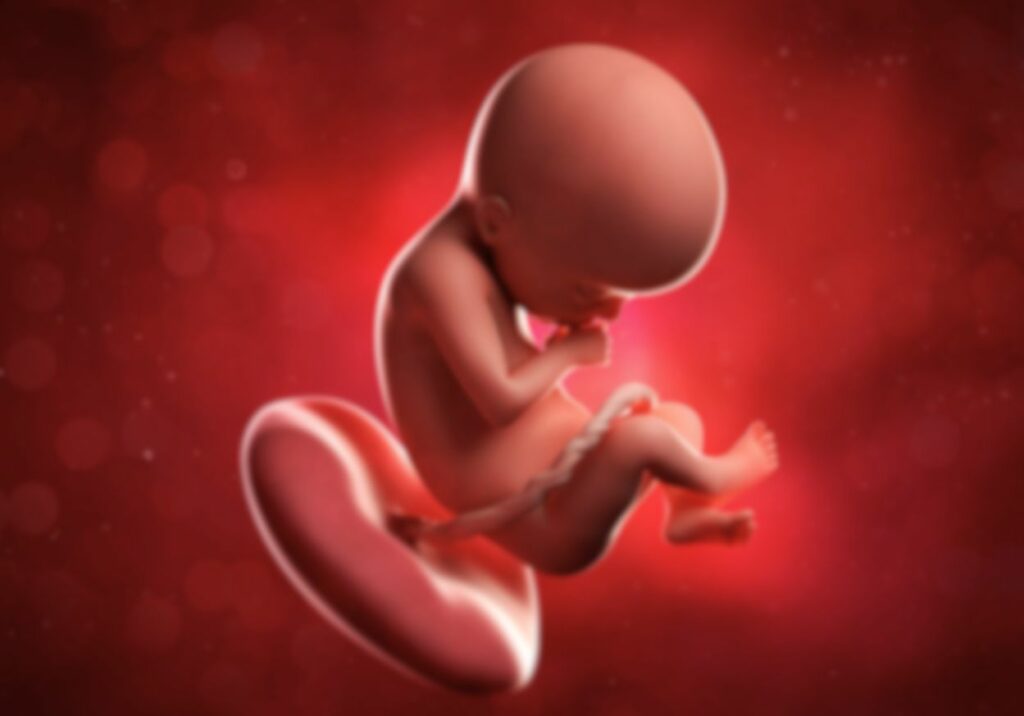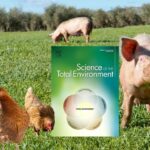
Titanium dioxide and silica nanoparticles: risks in pregnancy
Studies on the health impacts of manufactured nanomaterials to which women are exposed during pregnancy are extremely rare. A collaboration between several scientific teams has just demonstrated that, even when filtered by the placenta and not reaching the embryo or fetus, nanoparticles of titanium dioxide (TiO2) and silica (SiO2) pose health risks for the unborn child, in particular poor blood vessel development. These results confirm the need – and urgency – to exercise great caution when considering using these nanoparticles.
Could exposure to nanoparticles in pregnancy harm the development of the unborn child, and if so, how? An answer was very recently published by the journal Advanced Science,
in an article1Nanoparticles Dysregulate the Human Placental Secretomewith Consequences on Angiogenesis and Vascularization, Dugershaw-Kurzer B et al., Adv. Sci., 11, 2401060, 2024 written by scientists from various laboratories in Switzerland2Tina Buerki and her team from Empa’s “Particles-Biology Interactions” laboratory, as well as researchers from ETH Zurich, the Cantonal Hospital of St.Gallen (KSSG), the Swiss Institute of Bioinformatics (SIB) and the University of Geneva, the Netherlands3the University Hospital of Amsterdam and Germany4Leibniz Research Institute for Environmental Medicine in Düsseldorf. The title of the press release from Empa, the Swiss laboratory that led the study, sums it up more concisely and clearly for non-experts: “Nanoparticles: Risk to embryos in the womb”.
AVICENN contacted Dr. Tina Buerki from Empa’s Particles-Biology Interactions laboratory to get a better understanding of the ins and outs of this particularly important study. Here’s what we’ve learned.
Nanoparticles disrupt the secretion, by the placenta, of molecules that are essential for a healthy pregnancy
The researchers collected human placentas, some taken during the first trimester of pregnancy (following voluntary termination of pregnancy (abortion)5between the 7th and the 10th week of pregnancy), and others at term (following caesarean sections). They first exposed them to realistic doses of manufactured nanoparticles (titanium dioxide and silica) and diesel soot (incidental particles inhaled from air pollution). Then, they observed whether the secretion of placental signalling molecules, essential for the smooth progress of the pregnancy, was affected or not. What they found is particularly worrying → nanoparticles of titanium dioxide, silica and diesel soot alter various placental molecules that are essential for a healthy pregnancy:
- they alter not only substances playing a key role in immunity/inflammation (involved in miscarriage and pre-eclampsia) – and particularly so in the first trimester of pregnancy…
- … but also substances playing a key role in the formation and development of blood vessels (substances whose disruption is also associated with the onset of pre-eclampsia); the strongest alterations are generated by metal oxide nanoparticles (TiO2 and SiO2), more than by diesel soot.
These disturbances lead to poor blood vessel development, which is harmful to the fetus
Secondly, the researchers wanted to check whether the imbalances observed in the molecules secreted by the placenta following exposure to nanoparticles could have an impact in utero on fetal development. They placed various samples of the molecules obtained above in contact with fertilized chicken eggs’ membranes, to visualize the impact on blood vessel development.
Here again, adverse effects were observed: while the egg membranes of the ‘control’ group (with no prior exposure to nanoparticles) developed a dense, healthy network of blood vessels, there were clear deficiencies in the vascularization of egg membranes exposed to molecules secreted by placentas that had been exposed to the nanoparticles. Researchers reported enlarged avascular zones, abnormal vessel’ divisions and, in some cases, reduction in vessel lengths.
These effects were observed for all three types of particles – but even more so for samples taken during the first trimester of pregnancy, a particularly sensitive period.
Different effects for different types of nanoparticles
Although all the nanomaterials involved in this study had adverse effects on the development of blood vessels, there were significant differences in the way they affected the “cocktail” of substances secreted by the placenta (the “placental secretome”):
- metal oxide particles (SiO2 and TiO2) induced more pronounced disruption of pregnancy hormones or lysosomal proteins, which have important for immune responses and blood vessel remodeling;
- diesel soot, on the other hand, affected various inflammatory and vascular factors, possibly due to the presence of organic compounds or metals adsorbed to these pollution particles.
What about the effects on the nervous system?
The early development of the nervous system was only ‘negligibly’ affected, at least in this experimental protocol, which relied only on a single short term exposure.
Other experiments, conducted in vivo, have recently highlighted neuronal problems after a repeated daily exposure, like impaired breathing in newborns6See, for example, our article on the study carried out by researchers in Bordeaux in 2022, whose research also led to another, more recent publication. Cf. Effect of chronic prenatal exposure to the food additive titanium dioxide E171 on respiratory activity in newborn mice, Colnot E, O’Reilly J and Morin D, Frontiers in Pediatrics, 12:1337865, 2024: daily exposure of mice to titanium dioxide nanoparticles during gestation results in respiratory hyperventilation in newborn mice.
→ For more information, see our Infosheet What are the health risks of nanos? (‘Effects on the brain and nervous system (neurotoxicity)’ section)..
What’s next in terms of research?
Interviewed by AVICENN, Ioana Ferecatu, senior lecturer in Human Placental Physiopathology and Pharmacotoxicology at Université Paris Cité, who did not take part in the study but has carried out work related to the subject7Benzo(a)pyrene and Cerium Dioxide Nanoparticles in Co-Exposure Impair Human Trophoblast Cell Stress Signaling, Deval, G. et al, Int. J. Mol. Sci. 24, 5439, 2023, and Uptake of Cerium Dioxide Nanoparticles and Impact on Viability, Differentiation and Functions of Primary
Trophoblast Cells from Human Placenta, Nedder et al, Nanomaterials, 3;10(7):1309, 2020confirms “the relevance, robustness and high scientific quality of this innovative study, which makes important contributions to research into the impact of nanoparticles during pregnancy”. In her opinion, “the number of experiments carried out should be increased in order to improve the robustness and reliability of the results”. This is in line with projects of the study leader at Empa, who has also expressed to AVICENN her wish to verify, as part of future research, whether a dysregulated placental secretome could affect the development of other fetal organs besides blood vessels. She is currently developing “a new placenta-embryo-chip model to gain further insights into developmental toxicity mechanisms of nanomaterials on early human embryonic development” (which, incidentally, will make it possible to reduce animal experimentation).
The Swiss National Science Foundation (SNSF) funded the work described above. On the other side of the Atlantic, in the USA, the National Institute of Environmental Health Sciences (NIEHS) and the National Institutes of Health (NIH) are also funding some work on the subject8notably that of Phoebe Stapleton, from the Department of Pharmacology and Toxicology at Rutgers University.
However, in France and in the rest of the European Union, research into the effects of perinatal exposure to manufactured nanomaterials has been reduced to a bare minimum due to a lack of dedicated, long-term funding.
And yet, as our tests on everyday consumer products in 2022 have shown, women of childbearing age are particularly exposed to metal oxide nanomaterials. A few rare French research projects are still underway, thanks to funding obtained a few years ago via the national “environment – health – work” research program (PNR EST) of the French national health safety agency (ANSES)9See the XALUD project selected in 2022, the Agence Nationale de la Recherche (ANR)10See the PregNanoBaP project with cerium dioxide nanoparticles, or more recently via the Fondation pour la Recherche Médicale (FRM)11See the project by Muriel Thoby-Brisson (Inserm/INCIA) and Marion Tissier-Raffin. But they are far from being able to provide all the answers to the countless questions that arise in terms of knowledge about exposures to nanos and the associated health risks.
What are the concrete repercussions and actions?
Increased risk of miscarriage, pre-eclampsia, low birth weight, autism, respiratory illnesses, etc. In view of the potential complications that TiO2 and SiO2 nanoparticles may have on health, and particularly on pregnancy and the unborn child12See our sheet What are the heatlth risks of nanos? (under the heading “Effects on fertility and offspring” (reprotoxicity), a response from health authorities is essential.
Although titanium dioxide has been banned from foodstuffs, the question remains as to whether it should continue to be authorized for use in countless products, starting with toothpastes and medicines.
Many brands have already removed TiO2 from their toothpastes in recent years (CI77891), and pharmaceutical companies have also begun to remove TiO2 from certain medicines (Sanofi’s Doliprane tablets, for example, are now E171-free). The European Commission has given itself three years, between 2022 and 2025, to decide whether or not to maintain authorization for the excipient E171 in medicinal products, on the basis of an opinion that the European Medicines Agency (EMA) was supposed to provide last April – and which, for the moment at least, has remained confidential. (In a 2021 document, the EMA had argued for a “ten-year or more” delay to be granted to pharmaceutical companies…)
Meanwhile, in addition to the large number of oral medications, most progesterone gels and capsules prescribed to women undergoing MAP and IVF contain TiO2. It is not necessarily the same type of TiO2 as that tested by Empa and its partners: the size, coating, crystallinity and other parameters of the particles of which it is composed may be different, and therefore their effects may also be different from those highlighted by their experiment. Maybe… but today, there is no guarantee that the various types of TiO2 on the market are safe, as the European Committee for Consumer Safety (CCCS) recently pointed out13Cf. Scientific Advice on Titanium dioxide (TiO2), SCCS, 1661/23, May 2024 and our dedicated article: TiO2 in cosmetics: according to European experts, safety data are inconclusive, AVICENN @VeilleNanos, 17 juillet 2024
Under these conditions, “is it reasonable to simply hope that what we’re exposed to isn’t too dangerous, and cross our fingers… and our arms, when the health of unborn children is at stake?” asks Sylvie Platel, a doctor in public health and WECF’s environment health advocacy manager: “neither the public authorities nor the companies that market titanium dioxide or products containing it can disregard their potential deleterious effects; the protection of future generations, which has only begun to be taken into account on a legal standpoint, must become a priority”On this topic, see:
– Générations futures : un droit d’avenir – Entretien avec Emilie Gaillard, Sésame, 2022
– la Réunion internationale Réunion internationale “Justice, Générations futures et Environnement”, organized by the Constitutional Council in February 2024,
-the Declaration on Future Generations that will be discussed during the Summit of the Future organized by United Nations Secretary-General, Antonio Guterres, in New York
in September 202415.

Other nano-related news
Next nano events

- Webconference for analysis laboratories, plant fertilizer manufacturers and distributors, public authorities…
- Moderated by David Krupka, nanotechnologies development manager at AFNOR Normalisation and Emilie Langlois-Bertrand, nantechnologies standardization project manager.
- In partnership with Armand Masion, CNRS Research Director, and Sandrine Mocoeur, Health, Safety, Environment and Quality Manager at SYNGENTA.
- This exchange will also be an opportunity to explore the creation of a national platform to identify standardization needs.
- Website: www.afnor.org/evenement/nanotechnologies-agriculture-cadre-pratique-responsable/


- The webinar will present an overview of the key findings of the OECD report on safe and sustainable by design tools, integrative systems and platforms for nanomaterials and nano-enabled products and on its perspectives on how SSbD tools and systems can be applied in practice to support decision making, innovation and regulatory preparedness for nanomaterials and nano-enabled products.
- Organizer: OECD
- Website: https://meetoecd1.zoom.us/webinar/…

- International conference on metallic nano-objects for experts working in the interdisciplinary field of metallic nanoparticles, with a particular emphasis on nanoparticle synthesis and characterization, plasmonics, optics and photonics, catalysis, biomedicine, electronics, and nanoparticle recycling
- Organizers / Partners: CNRS, Bordeaux University, Bordeaux INP, ICMCB, CRPP, CBMN, ISM
- Website: https://mno2026.sciencesconf.org
Notes and references
- 1Nanoparticles Dysregulate the Human Placental Secretomewith Consequences on Angiogenesis and Vascularization, Dugershaw-Kurzer B et al., Adv. Sci., 11, 2401060, 2024
- 2Tina Buerki and her team from Empa’s “Particles-Biology Interactions” laboratory, as well as researchers from ETH Zurich, the Cantonal Hospital of St.Gallen (KSSG), the Swiss Institute of Bioinformatics (SIB) and the University of Geneva
- 3
- 4Leibniz Research Institute for Environmental Medicine in Düsseldorf
- 5between the 7th and the 10th week of pregnancy
- 6See, for example, our article on the study carried out by researchers in Bordeaux in 2022, whose research also led to another, more recent publication. Cf. Effect of chronic prenatal exposure to the food additive titanium dioxide E171 on respiratory activity in newborn mice, Colnot E, O’Reilly J and Morin D, Frontiers in Pediatrics, 12:1337865, 2024: daily exposure of mice to titanium dioxide nanoparticles during gestation results in respiratory hyperventilation in newborn mice.
→ For more information, see our Infosheet What are the health risks of nanos? (‘Effects on the brain and nervous system (neurotoxicity)’ section). - 7Benzo(a)pyrene and Cerium Dioxide Nanoparticles in Co-Exposure Impair Human Trophoblast Cell Stress Signaling, Deval, G. et al, Int. J. Mol. Sci. 24, 5439, 2023, and Uptake of Cerium Dioxide Nanoparticles and Impact on Viability, Differentiation and Functions of Primary
Trophoblast Cells from Human Placenta, Nedder et al, Nanomaterials, 3;10(7):1309, 2020 - 8
- 9See the XALUD project selected in 2022
- 10See the PregNanoBaP project with cerium dioxide nanoparticles
- 11
- 12See our sheet What are the heatlth risks of nanos? (under the heading “Effects on fertility and offspring” (reprotoxicity)
- 13Cf. Scientific Advice on Titanium dioxide (TiO2), SCCS, 1661/23, May 2024 and our dedicated article: TiO2 in cosmetics: according to European experts, safety data are inconclusive, AVICENN @VeilleNanos, 17 juillet 2024
- 14
Under these conditions, “is it reasonable to simply hope that what we’re exposed to isn’t too dangerous, and cross our fingers… and our arms, when the health of unborn children is at stake?” asks Sylvie Platel, a doctor in public health and WECF’s environment health advocacy manager: “neither the public authorities nor the companies that market titanium dioxide or products containing it can disregard their potential deleterious effects; the protection of future generations, which has only begun to be taken into account on a legal standpoint, must become a priority” - 15.




